Post by TasunkaWitko on Mar 19, 2013 9:34:24 GMT -5
My First Attempt at Bacalao al Pil-Pil
Salt Cod in Pil-Pil Sauce
When I first started collecting books of the Time/Life Foods of the World series, I immediately gravitated to the volume on Spain and Portugal and began reading it eagerly. I found the chapter on Basque cooking particularly interesting, with fascinating photos that drew me right in; it seemed that here was an area and a culture that was truly unique, and that uniqueness contributed to the cuisine. I found it fascinating that certain concepts would be so integral, not only to the land and the people, but to the food as well.
From Time/Life's Foods of the World - The Cooking of Spain and Portugal, 1969:
As I continued reading, I was introduced to several facets of the Basque culture that contributed to the well-deserved reputation for excellence that Basque cooks enjoy:
This idea of men getting together for the sole purpose of cooking and enjoying the bounty of the Basque table fascinated me, and it was natural to put myself in the position of a visitor to Basque country:
No study of Basque cuisine would be complete without broaching the subject of seafood, which is so integral to Basque cooking that it would be hard to imagine the cuisine without it. The proximity to the Bay of Biscay and the Atlantic assures that there will always be an abundant bounty from the ocean, ready to be brought to its highest elevation by skilled cooks with a built-in instinct for excellence and innovation:
One of the quintessential seafood dishes on Basque culture is Bacalao al Pil-Pil, which is salt cod cooked in simple and humble fashion with very little frivolity; this dish is the essence of Basque cooking in that the main ingredient is not only the star, but also the instrument of its own embellishment. This concept brings us back to the opening comments regarding pure ingredients, sauces, gravies. Time/Life elaborates:
The careful dance that results in the pil-pil sauce involves gentle heat and motion, emulsifying the natural juices of the cod into the garlic-infused oil that it is cooked in and creating a new ingredient that enhances and highlights its components. To me, it is an example of the fundamental truth that simple ingredients prepared simply will create their own elegance.
Interestingly, When I was researching this project, I found that the Guria restaurant in Bilbao, which prepared the bacalao al pil-pil pictured above, is still in existence. With a little bit of digging, I discovered that this quintessential Basque dish is still on their menu, and even found a modern photo showing their preparation of it:
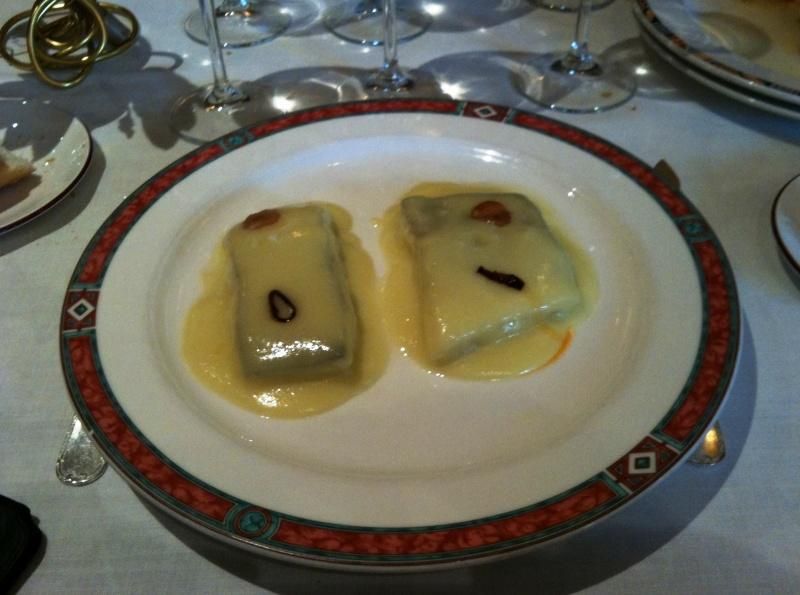
Photo credit: 1.bp.blogspot.com/-L1AR...HE/s1600/Pil-Pil.JPG
Note how the tablecloth design in the old photo is very similar to the rim of the plate in the new photo; it seems that in Basque country, the past and the present are always interwoven into a timeless tapestry.
My reading indicates that the dish that we've come to know as bacalao al pil-pil is not quite as it was originally made, although it is very close. According to at least two sources (Kurlansky and Busca Isusi), the original bacalao al pil-pil was prepared in the same tradition that eels were prepared, with gentle, sizzling cooking in olive oil, seasoned with garlic and perhaps a sliced pepper; however, the juices from the fish were not blended with the olive oil into a sauce - it was simply served, the same way that the eels are. It seems this method for cooking cod traces back to around the same time as a Basque uprising known as the Third Carlist War, circa 1830, when an abundance of salt cod procured through a clerical error necessitated innovative methods in cooking it. Eventually, it was discovered that the juices of the cooking cod, when subjected to gentle motion, would emulsify with the oil it was cooking in, resulting in a unique and delicious preparation.
To prepare this dish, I chose to use a recipe from Karlos Arguiñano, a renowned Basque chef who is known for his simple, elegant preparations of traditional Basque dishes. Below is my best attempt at a translation of Arguiñano's recipe, garnered from what Google's translation tool provided and supplemented with what I know about the dish as well as what I observed while watching the accompanying video. As you can see, the ingredients for the recipe are so basic - so minimalist - that the pure, unadulterated flavours are allowed to come through and be taken to a level that is bound only by the skill of the one preparing the dish:
When I made this dish for the first time, things did not go entirely as planned. Due to an execution error, the pil-pil sauce did not formulate the way it was supposed to, and in modern, technical terms, I failed in my goal. Having said that, what I ended up preparing was actually very close to the original way that bacalao al pil-pil was prepared, so I am calling it a "successful failure." The important thing, to me, is that the dish tasted excellent, and I had no complaints at all where flavour was concerned; indeed, the Beautiful Mrs. Tas, who is by no means a lover of fish, really enjoyed this dish, and in spite of the almost-prohibitive cost, she is looking forward to the next time I make it. I hope that my next attempt will allow me to achieve the goal of integrating the sauce the way it is intended to be.
In any case, here is a record of my first attempt at bacalao al pil-pil.…
The primary ingredient, of course, is salt cod. Living where I do, this is extremely difficult to procure; luckily I had the very good fortune to meet a most excellent friend a few years ago - you know him here as "Hoser," but I like to call him "Dave!" Anyway, since Dave lives near a bustling and thriving Portuguese community on the East Coast, he is able to come across a few things that are not easy to get around here, and he graciously sent a supply of salt cod to me:
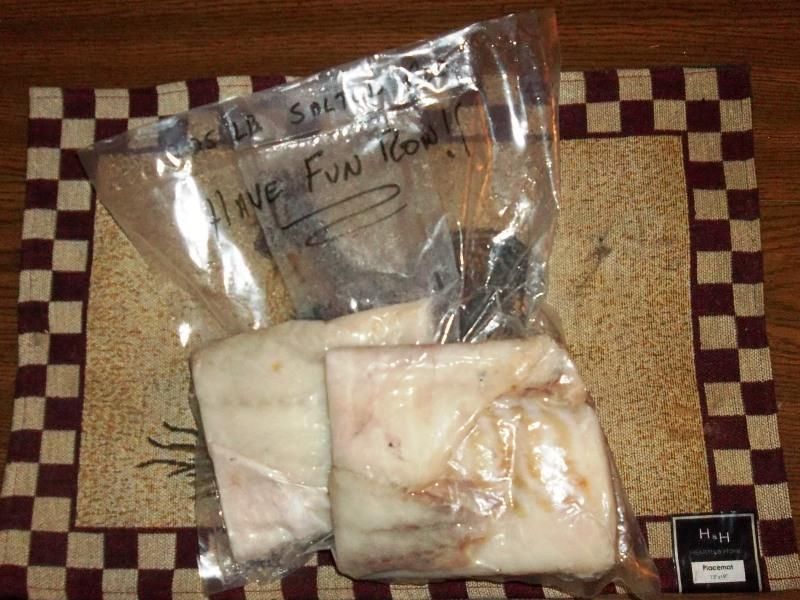
This salt cod came from A J Seabra, a chain of Portuguese supermarkets based in New Jersey, and was some really fine-quality stuff; it smelled fresh and ultimately had a wonderful flavour that seemed to be more than the sum of its components - a truly special treat that I will always remember fondly.
Dave also penned some advice:
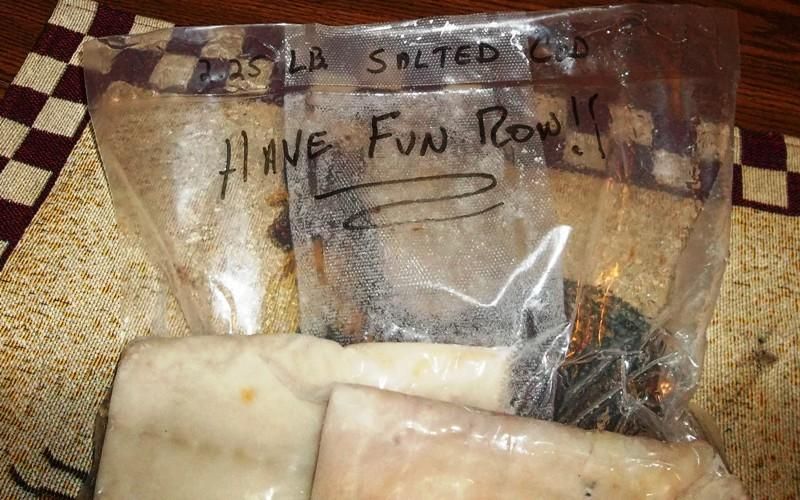
This admonition set a perfect tone for this project, and I must say that I had a great time with it ~ Thank you, Dave!
Salt cod is made by packing the cod fillets in sea salt, which preserves the fish via partial dehydration, creating a dry, salty environment where food-borne pathogens cannot grow. This is a very, very old method for preserving cod and other fish, and during the days before refrigeration, it allowed the humble codfish to create a huge amount of commerce as it fed much of the known world. Salt cod is not so common in these days of flash-frozen packaging, but it is still sought out as the preferred way to prepare many dishes, including this one.
In order to use salt cod in a dish, the excess salt must be soaked out. This has a secondary effect of "re-hydrating" the fillets, causing them to expand back to their original size, as well. There's nothing complicated about this process, simply submerge the fillets in an appropriate amount of fresh water:
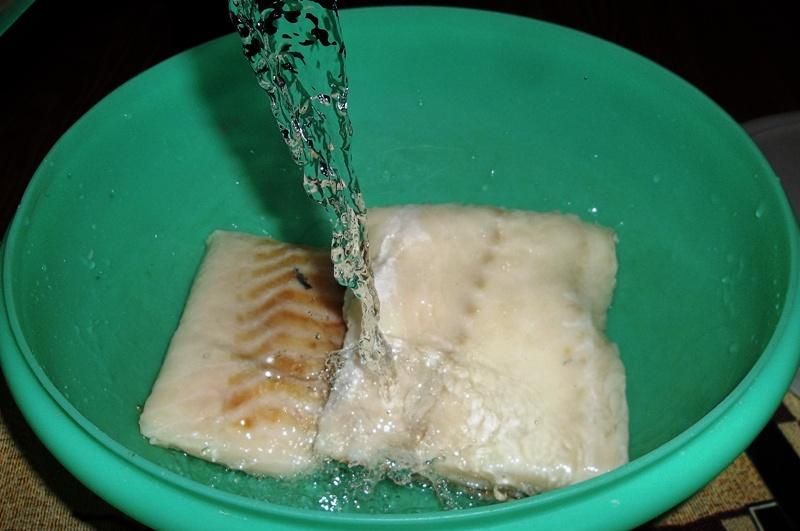
Once this was done, I covered the bowl:
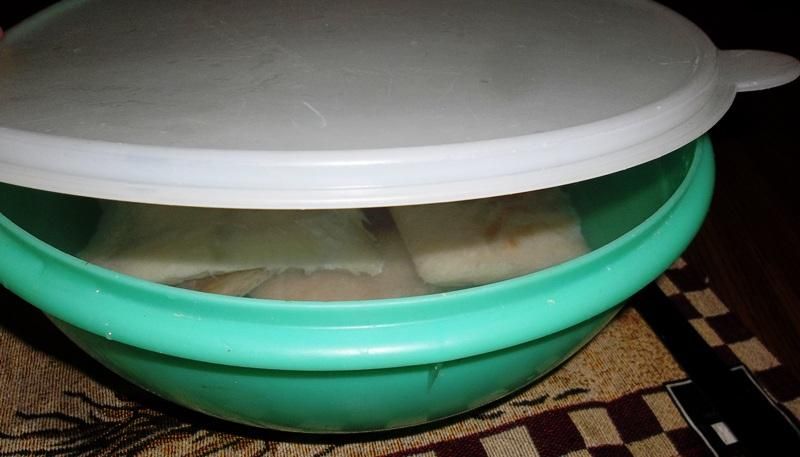
And placed it in the refrigerator. Over the course of the next 48 hours, I changed the water every 8 hours or so, until the water was no longer salty and I was ready to begin this dish.
One of the main things I love about this dish is how it is so quintessentially Basque in nature: it is simple, with few ingredients that are utilised to their maximum potential. Here's all you need:
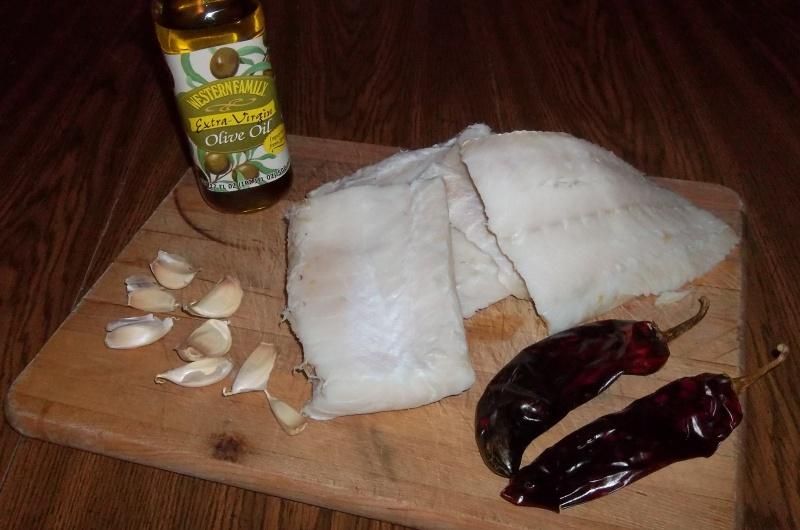
Olive oil (in this case, imported from Spain), garlic cloves, the de-salinated cod fillets and a couple of dried, red chiles.
A note about the chiles: Watching the video, I noticed that a long, triangular, dried red pepper is used, cut into strips, sautéed in olive oil to infuse some flavour, and then employed as a garnish for the finished dish. The chiles used in the video are evidently traditional dried espelette peppers, which are of course unavailable here and, even if available, would probably be too hot for the Beautiful Mrs. Tas - because of this, I set about looking for an acceptable substitute that would be more suited for our available resources and her preferences, without changing the dish too much. Based on what I was able to learn, and considering the availability of what I could find, I ultimately selected dried New Mexico chiles; they are dark red (the right colour), they are relatively mild, they are the right shape and - most importantly - they are available! They turned out to be a very good, flavourful choice, and I recommend them to anyone looking for a good substitute.
In any case, let's get started! First, I gently crushed and peeled the garlic cloves:
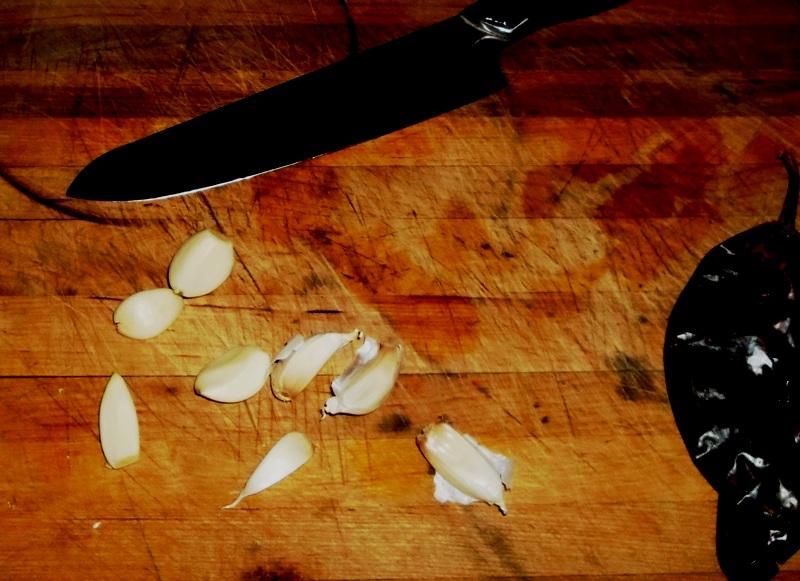
Sometimes, the garlic cloves are sliced longitudinally into "chips," but I elected to keep them whole this time, for simplicity's sake.
Next, I sliced the chiles into strips:
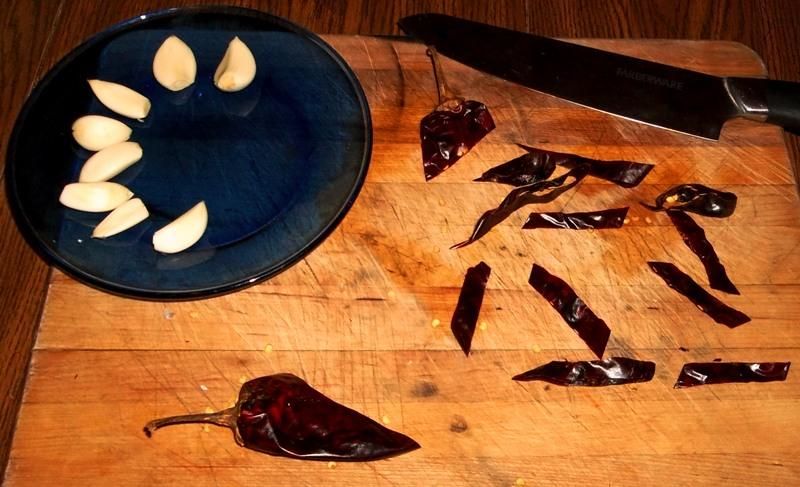
Then, I trimmed the cod fillets into uniform portions:
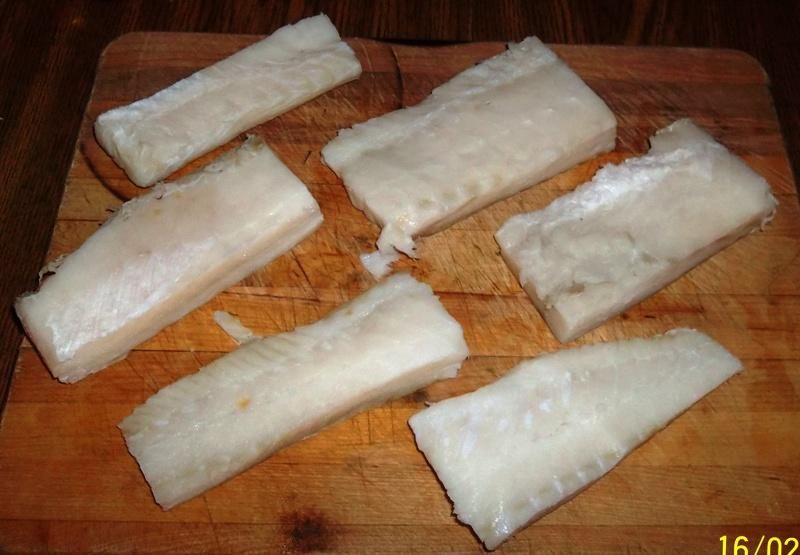
There were a few trimmings, bits and pieces that I reserved, intending to use them for other projects or perhaps a as a base for some fish stock.
Here we are with the few but oh so essential ingredients, ready to begin cooking:
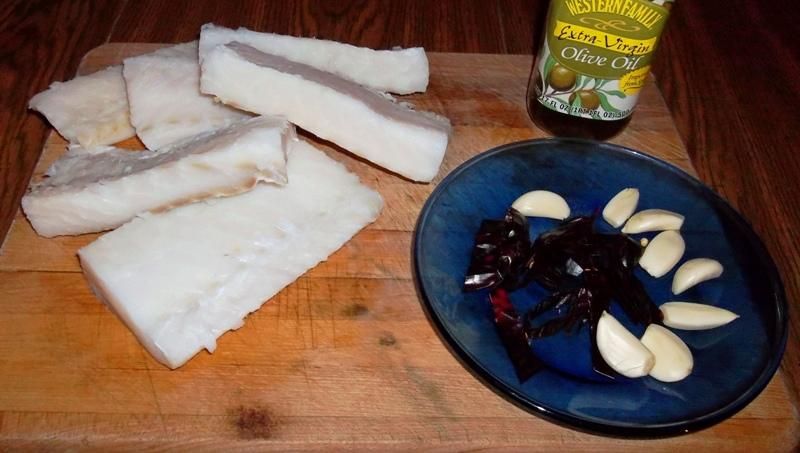
The only other ingredient that one might choose to employ would be parsley, as a garnish and for colour; however, in my town, there is no finding fresh parsley on a weekend, so I went without.
Aside from those few ingredients, there are of course some cookware and utensils that come in handy when making this dish; first and foremost is a glased, terra cotta cazuela:

This dish can surely be prepared most adequately with a stainless steel or other appropriate sauté pan; however, I figured that if I was going to do this, I might as well jump in and do it right, so I purchased a 12.8-inch (32.5-cm) cazuela from La Tienda:
www.latienda.com.
It was definitely a good purchase, and I am looking forward to using it for many Iberian and other projects.
In addition, there are a few other things that might prove helpful:

A plate to hold the garlic and dried chile strips once they are sautéed, a deep, wide platter to hold the cooked cod fillets and collect their juices, a small sieve, to begin the process of emulsifying the pil-pil sauce, and a wire whisk to use once the sauce enters a state where it is fairly stable.
To begin, I heated the olive oil to a medium and dropped in the garlic cloves, in order to infuse the garlic flavour into the oil and take on a slight toasted colour:
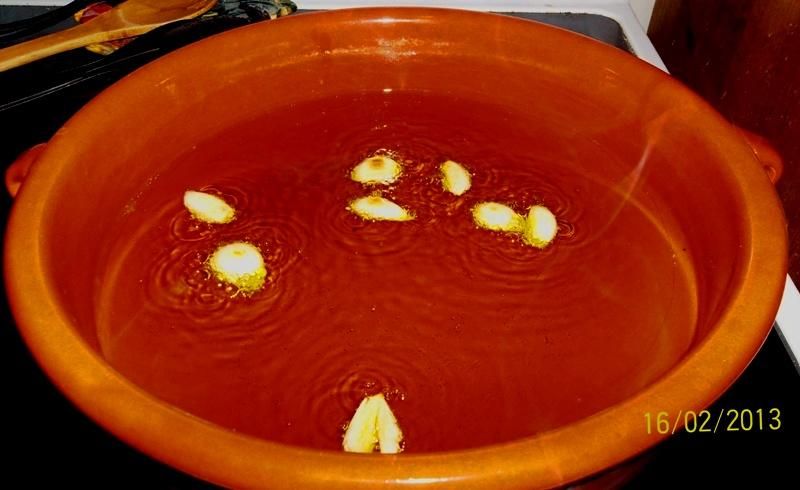
When the garlic cloves just started to take on colour, I dropped in the strips of dried chiles for just a few moments, to also flavour the oil:
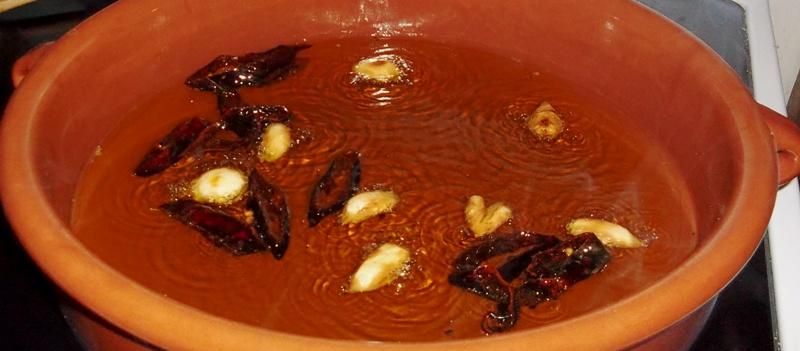
At this point, I also reduced the heat to low - or, at least I thought I did.
After removing the garlic cloves and strips of dried chiles, I waited a few minutes for the temperature of the oil to drop, then added the cod fillets:
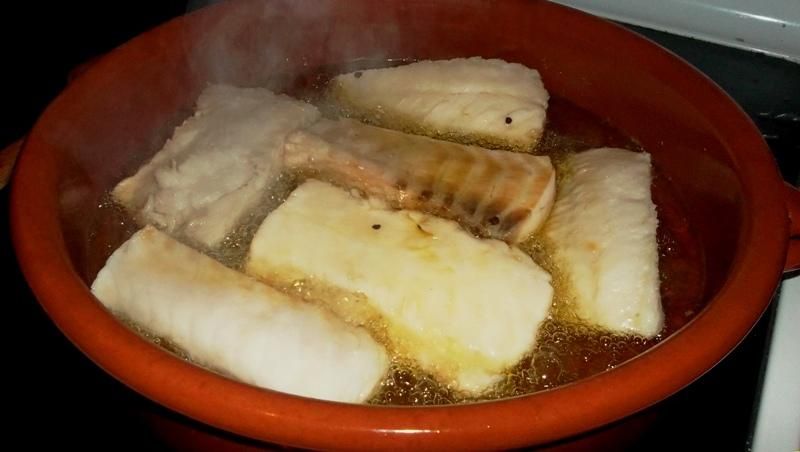
In Karlos's video, he does not seem very concerned about crowding the pan, so I put all of the fillets in, relying on the cazuela's outstanding heat retention properties to keep the oil from cooling too much.
After 4 minutes, I turned the fillets:
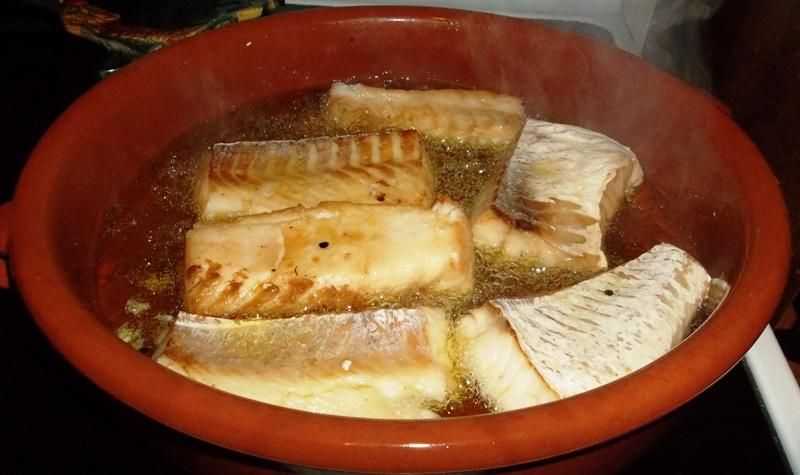
It was here that I noticed that the heat still seemed a little high, but since the knob on the stove indicated the lowest setting, I didn't think too much of it and assumed that the oil would continue cooling. What I didn't know at the time is that somehow the heat setting had not been reduced at all, and I was still cooking at full-on medium, which is much too hot for this dish at this stage.
When the cod fillets had cooked another 3 or 4 minutes on the second side, I removed them to the platter so that they could rest:
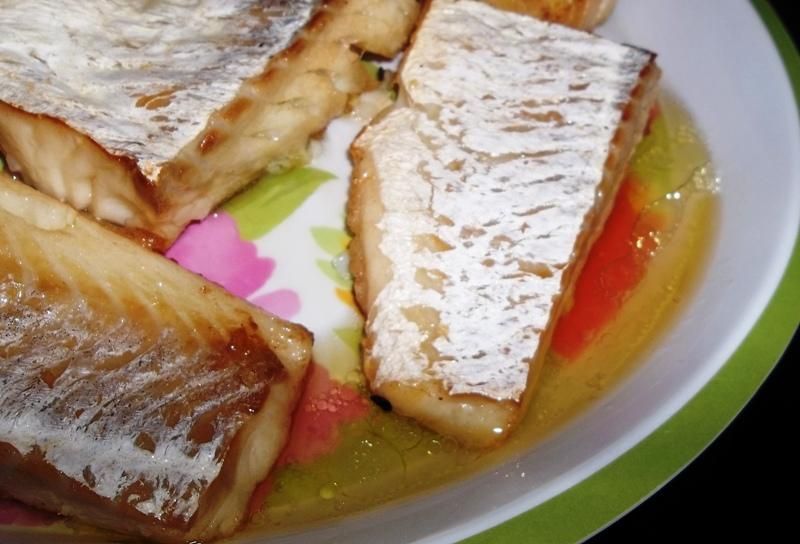
It is during this time that they should release their serum or juices, which will later be emulsified into the oil to form the pil-pil sauce; however, due to the high heat, most of the juices had been forced out into the cazuela and were cooked to the point where they were unable to be emulsified.
It was at this point that I noticed my error, and immediately turned the knob of the stove to off so that the cazuela could cool down and hopefully salvage the project, but unfortunately the damage had been done. Being the persistent person that I am, I tried to form the sauce anyway, turning the stove back on to the lowest setting (which worked fine this time) and whisking back and forth with the sieve:
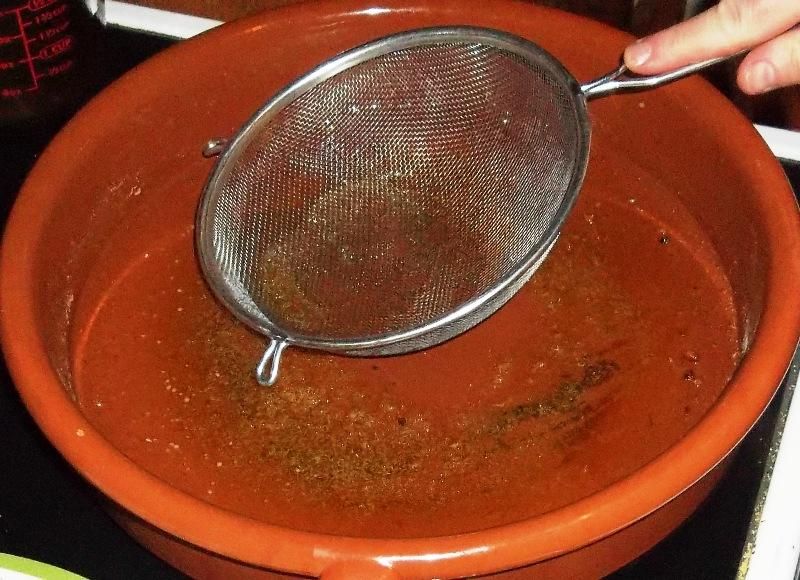
This had very little to no effect, as you can see, because the essential juices were cooked. I added the juices that had drained off the fish into the platter, but it wasn't enough to kick-start the process.
In my desperation, I added the few pieces of salt cod that resulted when I trimmed the fillets, hoping that they would release enough serum to form the sauce:
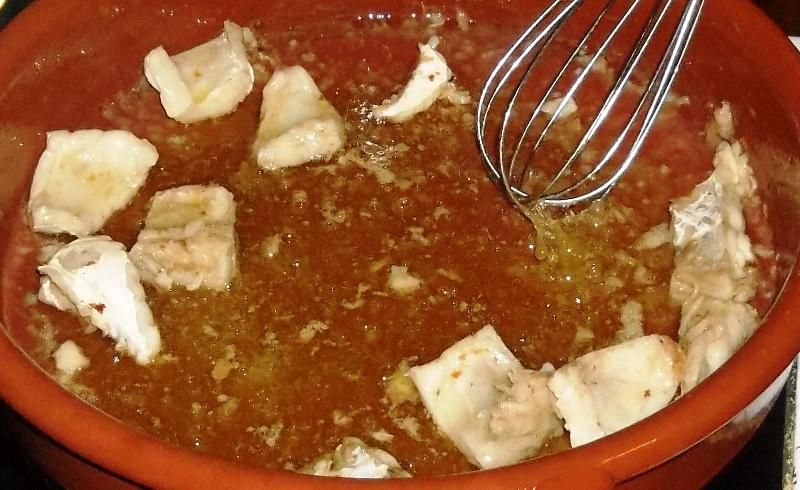
As you can see, it kept looking as though the process would start, but it never was able to sustain itself and form the sauce in the way that modern preparations do.
Be that as it may, I did have an excellent meal here, cooked very much in the way that the original bacalao al pil-pil had been prepared, so I returned the cod fillets to the cazuela in order to heat up a bit:

And then served my meal:
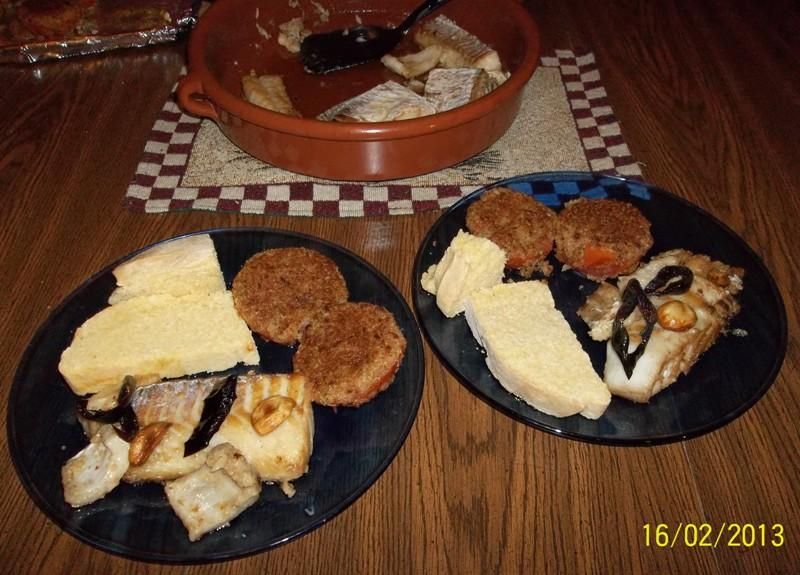
Aside from the lack of emulsified pil-pil sauce, the dish was quite a success, and tasted excellent.
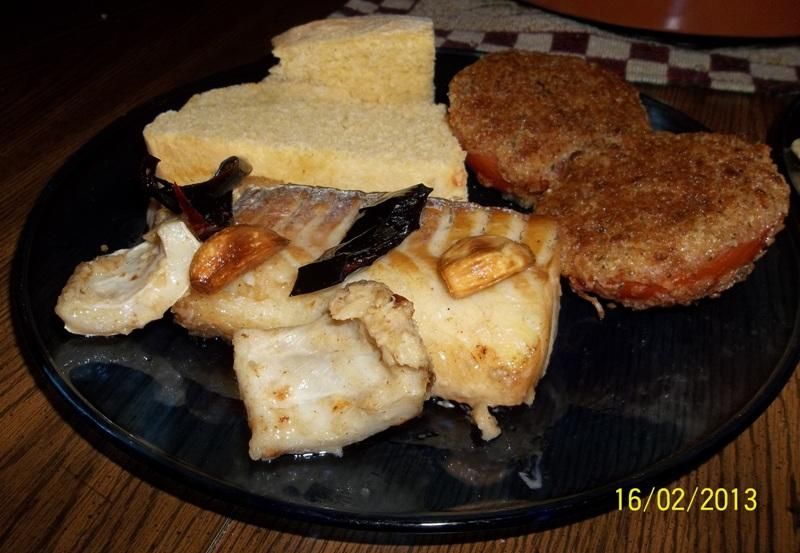
I had never had salt cod in any form before this, and was impressed with the way it picked up the flavours of the other ingredients: the olive oil, the toasted garlic and the fruity, slightly-spicy chiles.
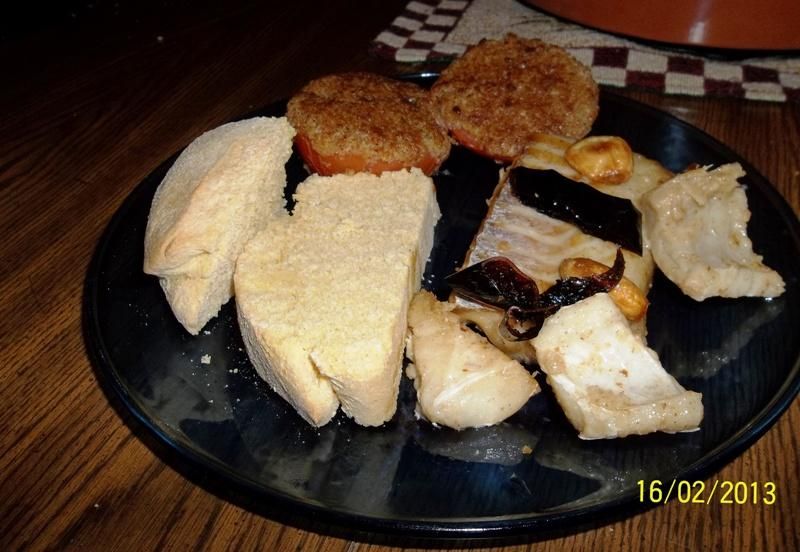
There was just a hint of salt flavour, to provide a nice, savory base, and the fish was firm and flaky in texture - probably just slightly over-cooked, but nonetheless delicious.
When choosing a bread to bake for this meal, I wanted something that would be Iberian in nature; something that would be plausible in Basque country and go well with a fish meal. Finally, I wanted to pay tribute to my friend Dave, and the Portuguese market where his gift came from. It wasn't long before I found the perfect choice, Portuguese corn bread:
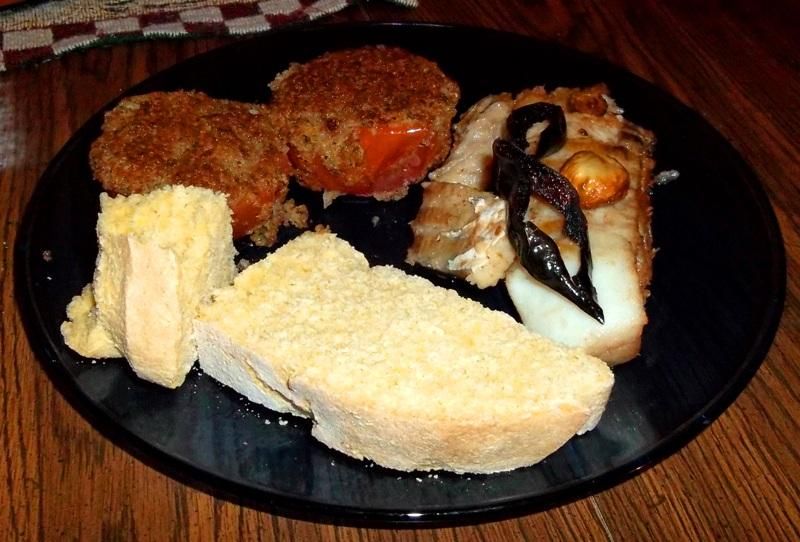
Corn is an important crop in Basque country, and fresh-baked breads are a fixture at nearly any meal. The corn bread was absolutely a great choice for this dish, and was enjoyed by all. Here's a link to a step-by-step pictorial on Portuguese cornbread, if you are interested:
foodsoftheworld.activeboards.net/po-do-milho_topic3361.html
For a side dish, I chose to try an idea that I got from Chris: broiled tomatoes topped with a butter-and-herb bread crumb mixture and a hint of Parmesan cheese:
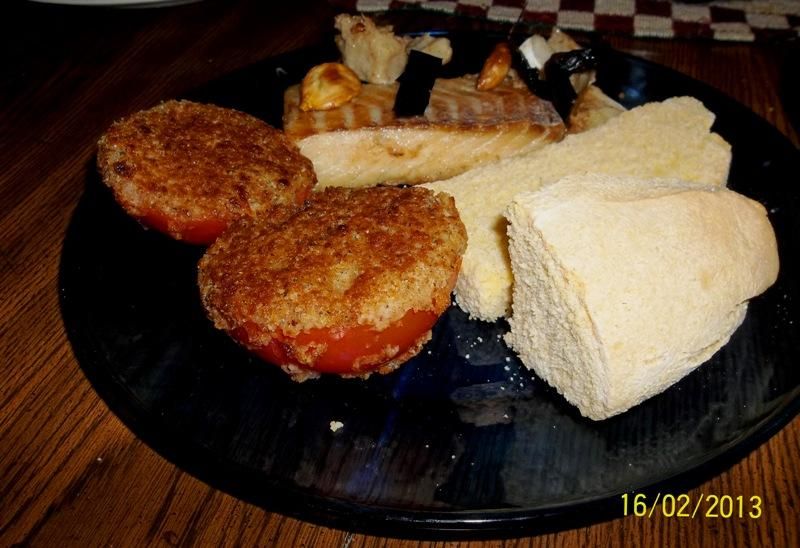
These were delightfully simple to make and bursting with wonderful flavours; the only real problem is that I used store-bought bread crumbs that seemed, to me, to be excessively fine and dry. In the future, I will make my own bread crumbs, which will hopefully provide a better texture. Having said that, the flavours of this simple tomato side dish were wonderful, and perfectly at home on a Basque plate, I think.
Over-all, this was an outstanding meal, in spite of a couple of minor execution errors, and provided a wonderful introduction to the Basque traditions of cooking seafood. I will - most definitely - be preparing this again, as soon as I can get my hands on some more salt cod.
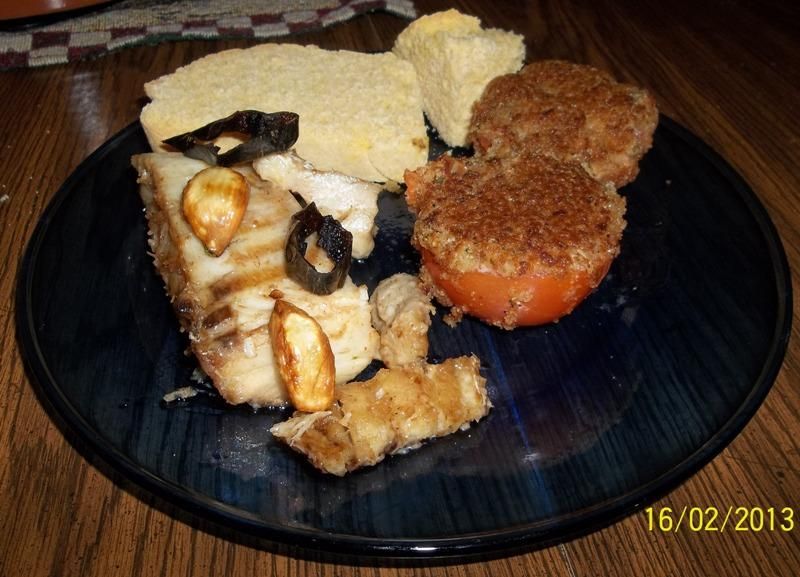
Thanks for taking the time to read this - I hope you enjoyed the experience as much as I did. If anyone wants to try this, please feel free to ask any questions, and I will get some answers for you. As you can see from reading this report, one primary rule must be to keep your heat low; trust your cookware to do the cooking for you, and pay careful attention to procedure and detail. If you do this, there is no reason why you can't enjoy success on your first attempt; however, even if it doesn't work out as you plan, chances are that you will still end up with a wonderful and delicious Basque meal.
Ron
Salt Cod in Pil-Pil Sauce
When I first started collecting books of the Time/Life Foods of the World series, I immediately gravitated to the volume on Spain and Portugal and began reading it eagerly. I found the chapter on Basque cooking particularly interesting, with fascinating photos that drew me right in; it seemed that here was an area and a culture that was truly unique, and that uniqueness contributed to the cuisine. I found it fascinating that certain concepts would be so integral, not only to the land and the people, but to the food as well.
From Time/Life's Foods of the World - The Cooking of Spain and Portugal, 1969:
The cooking of northeastern Spain is almost as concerned with sauces as that of the Levante is concerned with rice - though at first glance the visitor may not realise this, for the kitchens of [the Basque region] do not recognise the distinction others make between the two terms, sauce and gravy. For most cooks, gravy is the liquid juices of the food, while a sauce is more or less an additive, usually served separately. But here, the two are one and the same: juices and separate ingredients are nearly always cooked together with the food itself until they are indistinguishably mixed. And if the key term in the dining rooms of this culinary zone is sauce, which refers to the final product, the magic word in the kitchens is blend - the process by which the product is achieved....
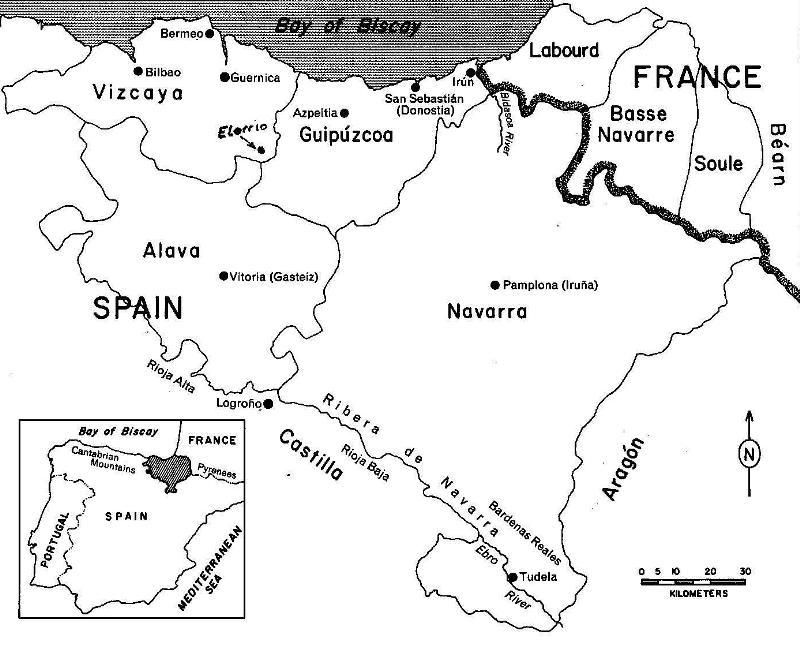
From Traditional Basque Cooking: History and Preparation, by José María Busca Isusi, 1993
The history of the people who live in the three Spanish Basque provinces of Guipúzcoa, Vizcaya and Álava[, with Navarra acting as a "bridge" to the French Basque provinces,] is covered by a haze like one of those sudden, blinding fogs that sweep south from the fish-laden Bay of Biscay to hide the land and the people - shining clear in the sun one minute, gone the next. No one knows exactly who the Basques are or where they came from. There are many theories; the one currently in vogue claims that the Basque peoples trace back to the original Iberians who first came to the Peninsula. The biting, fractured syllables of the rounded Basque language, Euskera, are not even vaguely similar to the sounds of Castilian, Catalan or even Portuguese - for Basque is not a Romance language and therefore does not have the same root. It is as foreign to the ears of any other Spaniard as Castilian would be to a Japanese....

From Traditional Basque Cooking: History and Preparation, by José María Busca Isusi, 1993
The history of the people who live in the three Spanish Basque provinces of Guipúzcoa, Vizcaya and Álava[, with Navarra acting as a "bridge" to the French Basque provinces,] is covered by a haze like one of those sudden, blinding fogs that sweep south from the fish-laden Bay of Biscay to hide the land and the people - shining clear in the sun one minute, gone the next. No one knows exactly who the Basques are or where they came from. There are many theories; the one currently in vogue claims that the Basque peoples trace back to the original Iberians who first came to the Peninsula. The biting, fractured syllables of the rounded Basque language, Euskera, are not even vaguely similar to the sounds of Castilian, Catalan or even Portuguese - for Basque is not a Romance language and therefore does not have the same root. It is as foreign to the ears of any other Spaniard as Castilian would be to a Japanese....
As I continued reading, I was introduced to several facets of the Basque culture that contributed to the well-deserved reputation for excellence that Basque cooks enjoy:
Paradoxically, Basque cooking is not foreign or alien to other Spanish palates. Its distinction is not in its strangeness, for unlike the language and the many other Basque traits, Basque food is not removed from the rest of the Peninsula by history or custom.... [T]he Basque kitchen is not the most individual of the Spanish kitchens. It is merely the best.... Walk into a Basque kitchen abruptly, for there is no proper introduction to Basque food. Like the Basque people and their language, Basque cooking seems to come out of nowhere, a part of the earth, a thing in itself.... The fierce excellence of Basque cooking is at least partly due to the masculine energy, exuberance and fire of the Basques themselves.... The Basque [man] is so sure of his uniqueness [that] he does not even need to consider it. He simply goes out and practices living in what is the most natural way for him.... His true purpose is not to be different, but only to excel....
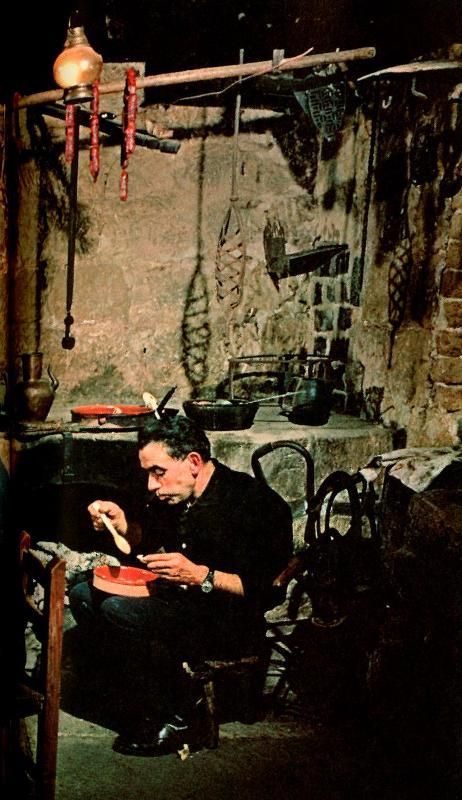
Male gatherings devoted to cooking...are a popular social form in Spain. The men prepare their own repasts, accompanying the cooking and eating with singing, dancing, singing and male talk. Such gatherings range from formal Basque gastronomic societies, which turn out some of Spain's finest dishes, to casual get-togethers of neighbours like those [pictured here] in a farm house in Palencia province:

First, the men cooked a chick-pea stew (potatje de titos), shown simmering below beside a brace of veal chops:
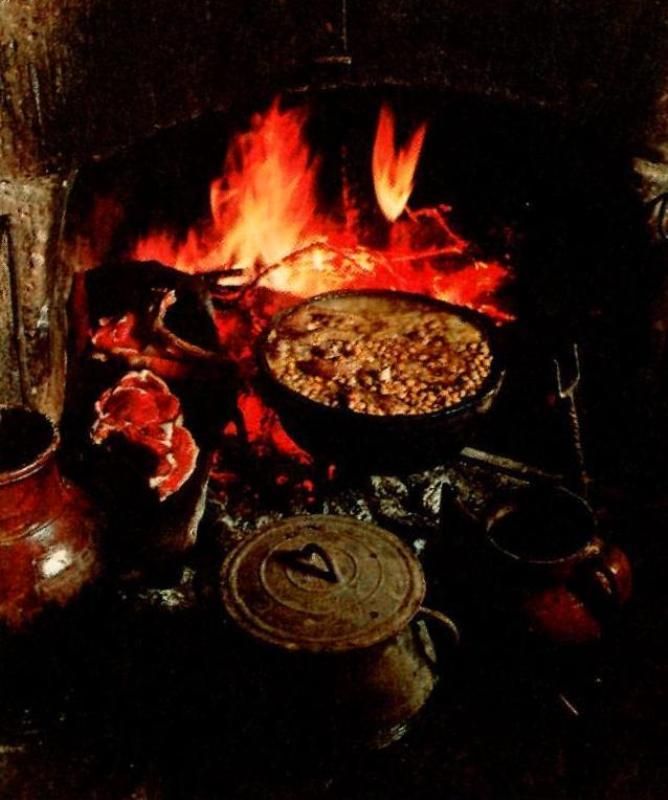
When it was done, they served themselves huge portions of it, washing it down with red wine; then they danced and sang to the music of the antique violins, shown hanging from a rafter [in the photo above], until the wineskins ran dry....

Male gatherings devoted to cooking...are a popular social form in Spain. The men prepare their own repasts, accompanying the cooking and eating with singing, dancing, singing and male talk. Such gatherings range from formal Basque gastronomic societies, which turn out some of Spain's finest dishes, to casual get-togethers of neighbours like those [pictured here] in a farm house in Palencia province:

First, the men cooked a chick-pea stew (potatje de titos), shown simmering below beside a brace of veal chops:

When it was done, they served themselves huge portions of it, washing it down with red wine; then they danced and sang to the music of the antique violins, shown hanging from a rafter [in the photo above], until the wineskins ran dry....
This idea of men getting together for the sole purpose of cooking and enjoying the bounty of the Basque table fascinated me, and it was natural to put myself in the position of a visitor to Basque country:
In serving any kind of food, the Basque demonstrates his excellence to such a degree that the menus of all the restaurants in Spain echo his foods. Any dish followed by the phrase a la vasca (in the Basque manner) is worth ordering if the cook has used the original recipe. So are dishes marked a la vasconia, a la vizcaína, a la vascongada (all of which are variations of a la vasca. Dishes that bear the markings a la bilbaína, a la iruñesa, a la donostiarra, a la vergarense, a la guipuzcoana, a la tolosana or a la easo are from Basque towns or provinces. Whatever the name, if it is authentic Basque dish, order it in any restaurant; you really can't go wrong.
But if you are introduced to Basque cooking in one of the private Basque gastronomic societies themselves, you will be served the kind of meal not to be found anywhere else in the world. The great gastronomic societies are set apart for those who truly like fine food and cooking; membership is limited, and a young Basque wishing to join must usually wait until an older member's departure for kitchens of ht next world has left a space in this one.... If you want to see inside one, there are only two requirements. First, you must be invited by a member as his guest. Second, you must be a man, for food and cooking in the Basque provinces is and has always been solely man's work. Basque women are respected, loved, and treated with infinite attention and kindness - in their proper place. Their proper place is not the kitchen.
When inviting you, your host will look guardedly to his right and his left, and with something faintly like a leer, will ask, "Are you a man who likes food. . . ?" in the tone of voice usually reserved by men for another kind of question. Say yes, and walk with him down the brown-grey cobblestone streets of San Sebastián's old quarter on the evening of a spring day, through the gusts and sharp sea breezes. The white clay, backed by low hills, is cupped around the sparkling blue Bay of Biscay....
Walk now up a steep hill ending at a building with a large oak door, and your host will pull out a large key and unlock the sanctuary. Every member has such a key, and when the door is unlocked you enter through the foyer into the single big room that is thick with the smells of simmering seafoods and herbs, fresh country vegetables and fowl and meat. This is the banquet room, living room and reading room combined; in fact, it is the only room. Long, solid, dark tables line the clean, white walls, benches on one side, chairs on the other. The room is functional and comfortable, but there is none of the attempt at luxury of the usual men's club; men come here to sit up and eat well, not to sink into the leather cushions and doze. Here the general rule is that no man wears a necktie, let alone a jacket. On the left as you walk in is a wall-niche containing a round object that looks like a roulette wheel with slits that empty into a big communal cup at the centre. This is the money till, where at the end of the week each member pays for what he has eaten or drunk. The honour system reigns. No man checks up on other members, no one asks to see what anyone else puts in the till, and each man keeps his own accounts. Life here is democratic; as you walk in, you will see lawyers, bankers, fishermen and salesmen sitting together and walking or reading their newspapers before dinner, side by side at the wooden tables. To the right is an alcove where liquors and apéritifs are kept, but there is no bartender; each man helps himself and his neighbours....Wine is brought in barrels and bottled on the premises; beer comes in vast kegs. At the far end of the room, with no separation, is the [vast, well-equipped] kitchen... A robust man of about 55 is cleaning and washing several soles; another younger man is cutting up a chicken and preparing to brown it in oil after dotting it with garlic, parsley and paprika; another can be seen chopping onions and keeping an eye on a steaming casserole that smells of lobster and white wine. Any of them will show you what he is doing, how he is doing it, or why there is not any other way of doing it that will come out exactly right. There are no secrets here.

Photo credit: www.foodsfromspain.com/...s_pano_SOCGASTRO.jpg
Being a guest at one of the Basque gastronomic societies is like being the only non-famous person at a Hollywood cocktail party: everybody talks to you. Each chef here is a star, and a man who cannot cook at all is very much in demand because everybody else can cook for him. Your host had better keep a tight hold on you if you are not a born chef, for you are a rare commodity. The minute you sit down, someone will come up asking you just to try this or only to taste that....
But if you are introduced to Basque cooking in one of the private Basque gastronomic societies themselves, you will be served the kind of meal not to be found anywhere else in the world. The great gastronomic societies are set apart for those who truly like fine food and cooking; membership is limited, and a young Basque wishing to join must usually wait until an older member's departure for kitchens of ht next world has left a space in this one.... If you want to see inside one, there are only two requirements. First, you must be invited by a member as his guest. Second, you must be a man, for food and cooking in the Basque provinces is and has always been solely man's work. Basque women are respected, loved, and treated with infinite attention and kindness - in their proper place. Their proper place is not the kitchen.
When inviting you, your host will look guardedly to his right and his left, and with something faintly like a leer, will ask, "Are you a man who likes food. . . ?" in the tone of voice usually reserved by men for another kind of question. Say yes, and walk with him down the brown-grey cobblestone streets of San Sebastián's old quarter on the evening of a spring day, through the gusts and sharp sea breezes. The white clay, backed by low hills, is cupped around the sparkling blue Bay of Biscay....
Walk now up a steep hill ending at a building with a large oak door, and your host will pull out a large key and unlock the sanctuary. Every member has such a key, and when the door is unlocked you enter through the foyer into the single big room that is thick with the smells of simmering seafoods and herbs, fresh country vegetables and fowl and meat. This is the banquet room, living room and reading room combined; in fact, it is the only room. Long, solid, dark tables line the clean, white walls, benches on one side, chairs on the other. The room is functional and comfortable, but there is none of the attempt at luxury of the usual men's club; men come here to sit up and eat well, not to sink into the leather cushions and doze. Here the general rule is that no man wears a necktie, let alone a jacket. On the left as you walk in is a wall-niche containing a round object that looks like a roulette wheel with slits that empty into a big communal cup at the centre. This is the money till, where at the end of the week each member pays for what he has eaten or drunk. The honour system reigns. No man checks up on other members, no one asks to see what anyone else puts in the till, and each man keeps his own accounts. Life here is democratic; as you walk in, you will see lawyers, bankers, fishermen and salesmen sitting together and walking or reading their newspapers before dinner, side by side at the wooden tables. To the right is an alcove where liquors and apéritifs are kept, but there is no bartender; each man helps himself and his neighbours....Wine is brought in barrels and bottled on the premises; beer comes in vast kegs. At the far end of the room, with no separation, is the [vast, well-equipped] kitchen... A robust man of about 55 is cleaning and washing several soles; another younger man is cutting up a chicken and preparing to brown it in oil after dotting it with garlic, parsley and paprika; another can be seen chopping onions and keeping an eye on a steaming casserole that smells of lobster and white wine. Any of them will show you what he is doing, how he is doing it, or why there is not any other way of doing it that will come out exactly right. There are no secrets here.

Photo credit: www.foodsfromspain.com/...s_pano_SOCGASTRO.jpg
Being a guest at one of the Basque gastronomic societies is like being the only non-famous person at a Hollywood cocktail party: everybody talks to you. Each chef here is a star, and a man who cannot cook at all is very much in demand because everybody else can cook for him. Your host had better keep a tight hold on you if you are not a born chef, for you are a rare commodity. The minute you sit down, someone will come up asking you just to try this or only to taste that....
No study of Basque cuisine would be complete without broaching the subject of seafood, which is so integral to Basque cooking that it would be hard to imagine the cuisine without it. The proximity to the Bay of Biscay and the Atlantic assures that there will always be an abundant bounty from the ocean, ready to be brought to its highest elevation by skilled cooks with a built-in instinct for excellence and innovation:
The Basque kitchen is at its best in cooking seafood, and every variety is to be found, prepared in more ways that would seem possible....[It] is said that no fish or seafood tastes as good as when it comes from the cold Bay of Biscay.
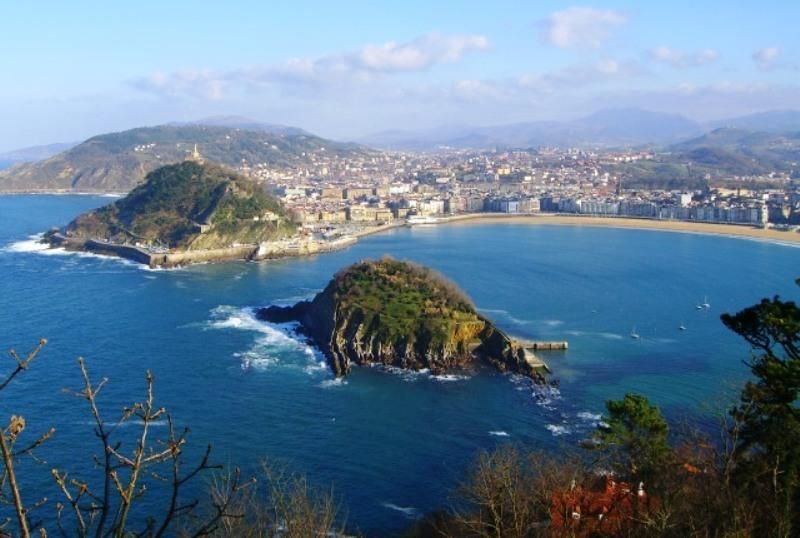
Photo credit:
The Basques are snobbish about seafood, no matter how fresh, that is taken from other waters. A fish, they claim, relaxes too much in the warm Mediterranean and loses its vitality and taste; too far north in the Atlantic the fish, except for cod, are so cold they lose their taste through rigidity. But catch a fish in the blue-grey waters of the Bay of Biscay, and it will be vibrant and alive with taste, ready for the kitchens of Basque chefs who give it the treatment it deserves.

Photo credit:
The Basques are snobbish about seafood, no matter how fresh, that is taken from other waters. A fish, they claim, relaxes too much in the warm Mediterranean and loses its vitality and taste; too far north in the Atlantic the fish, except for cod, are so cold they lose their taste through rigidity. But catch a fish in the blue-grey waters of the Bay of Biscay, and it will be vibrant and alive with taste, ready for the kitchens of Basque chefs who give it the treatment it deserves.
One of the quintessential seafood dishes on Basque culture is Bacalao al Pil-Pil, which is salt cod cooked in simple and humble fashion with very little frivolity; this dish is the essence of Basque cooking in that the main ingredient is not only the star, but also the instrument of its own embellishment. This concept brings us back to the opening comments regarding pure ingredients, sauces, gravies. Time/Life elaborates:
Three principal ingredients of the Basque dish bacalao al pil-pil are salt cod, garlic and olive oil.
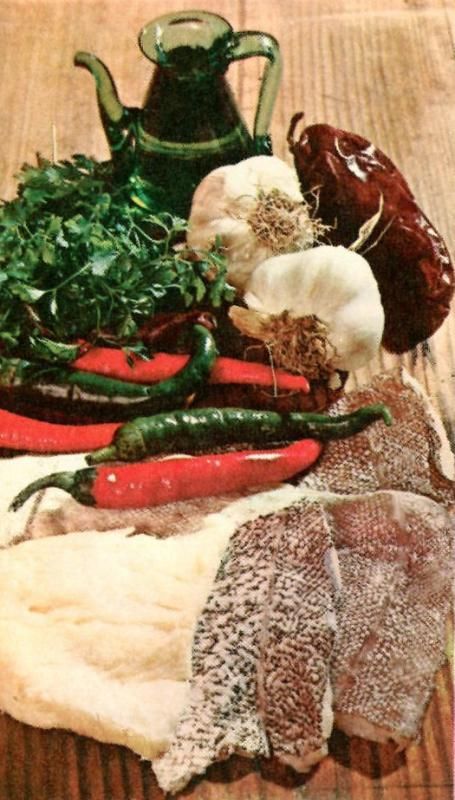
Other ingredients, such as the peppers and parsley included above, may be used as garnishes. Bacalao al pil-pil is served in the earthenware pot in which it cooks. When placed on the table at the Guria restaurant in Bilbao (below) it is accompanied by a glass of txakoli, a local white wine. A wedge of cheese made from sheep's milk serves as dessert.
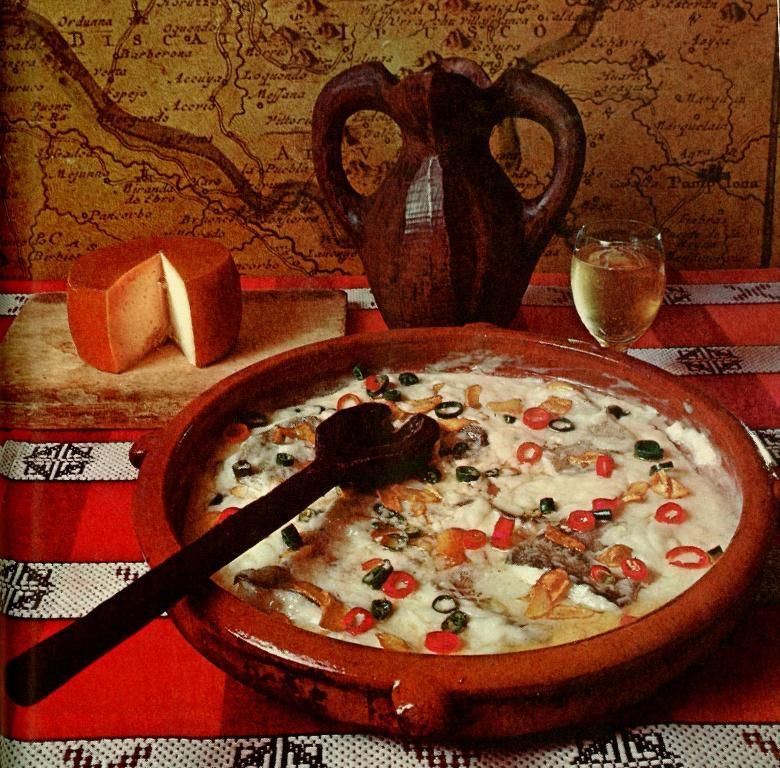
[Pil-pil sauce is made by combining] garlic and oil and the juices of the fish, but the dish is never stirred. In the Basque kitchen, a casserole is more often gently shaken or jiggled during cooking to prevent the food from sticking, and it is simmered very slowly until the fish juices have blended perfectly with the olive oil to make the sauce - the taste of which, in this land of sauces, might be described as what the fish meant by being a fish. As a rule, the Basques do not believe in adding things to a sauce that will suddenly change its taste, for they do not want the taste changed. The texture and flavour of a sauce grow gradually out of the basic ingredients; little seasoning, if any, is used.... The Basques believe that taste, texture, colour and the wholeness of the sauce must be a subtle combination of simple ingredients blended by the hands of a [cook] who respects the natural flavours of the foods enough not to disguise them, but rather to work to bring them out as strongly as possible. That, perhaps, is the singe aim of all fine cooking in the zone of sauces; the level of quality is high because of it.

Other ingredients, such as the peppers and parsley included above, may be used as garnishes. Bacalao al pil-pil is served in the earthenware pot in which it cooks. When placed on the table at the Guria restaurant in Bilbao (below) it is accompanied by a glass of txakoli, a local white wine. A wedge of cheese made from sheep's milk serves as dessert.

[Pil-pil sauce is made by combining] garlic and oil and the juices of the fish, but the dish is never stirred. In the Basque kitchen, a casserole is more often gently shaken or jiggled during cooking to prevent the food from sticking, and it is simmered very slowly until the fish juices have blended perfectly with the olive oil to make the sauce - the taste of which, in this land of sauces, might be described as what the fish meant by being a fish. As a rule, the Basques do not believe in adding things to a sauce that will suddenly change its taste, for they do not want the taste changed. The texture and flavour of a sauce grow gradually out of the basic ingredients; little seasoning, if any, is used.... The Basques believe that taste, texture, colour and the wholeness of the sauce must be a subtle combination of simple ingredients blended by the hands of a [cook] who respects the natural flavours of the foods enough not to disguise them, but rather to work to bring them out as strongly as possible. That, perhaps, is the singe aim of all fine cooking in the zone of sauces; the level of quality is high because of it.
The careful dance that results in the pil-pil sauce involves gentle heat and motion, emulsifying the natural juices of the cod into the garlic-infused oil that it is cooked in and creating a new ingredient that enhances and highlights its components. To me, it is an example of the fundamental truth that simple ingredients prepared simply will create their own elegance.
Interestingly, When I was researching this project, I found that the Guria restaurant in Bilbao, which prepared the bacalao al pil-pil pictured above, is still in existence. With a little bit of digging, I discovered that this quintessential Basque dish is still on their menu, and even found a modern photo showing their preparation of it:

Photo credit: 1.bp.blogspot.com/-L1AR...HE/s1600/Pil-Pil.JPG
Note how the tablecloth design in the old photo is very similar to the rim of the plate in the new photo; it seems that in Basque country, the past and the present are always interwoven into a timeless tapestry.
My reading indicates that the dish that we've come to know as bacalao al pil-pil is not quite as it was originally made, although it is very close. According to at least two sources (Kurlansky and Busca Isusi), the original bacalao al pil-pil was prepared in the same tradition that eels were prepared, with gentle, sizzling cooking in olive oil, seasoned with garlic and perhaps a sliced pepper; however, the juices from the fish were not blended with the olive oil into a sauce - it was simply served, the same way that the eels are. It seems this method for cooking cod traces back to around the same time as a Basque uprising known as the Third Carlist War, circa 1830, when an abundance of salt cod procured through a clerical error necessitated innovative methods in cooking it. Eventually, it was discovered that the juices of the cooking cod, when subjected to gentle motion, would emulsify with the oil it was cooking in, resulting in a unique and delicious preparation.
To prepare this dish, I chose to use a recipe from Karlos Arguiñano, a renowned Basque chef who is known for his simple, elegant preparations of traditional Basque dishes. Below is my best attempt at a translation of Arguiñano's recipe, garnered from what Google's translation tool provided and supplemented with what I know about the dish as well as what I observed while watching the accompanying video. As you can see, the ingredients for the recipe are so basic - so minimalist - that the pure, unadulterated flavours are allowed to come through and be taken to a level that is bound only by the skill of the one preparing the dish:
Recipe for Bacalao al pil-pil
By Karlos Arguiñano
This is the traditional recipe for bacalao al pil-pil prepared as by Chef Karlos Arguiñano.
Bacalao al pil-pil is one of the most traditional recipes; the preparation is simple but requires practice, and its result is spectacular. Pil-pil is the name of the sauce that slowly develops when the juices of the cod thicken and are blended with the olive oil while cooking the cod.
To desalt the cod, you must first pass the pieces under running tap water and then place them in a container with fresh water in the refrigerator (to not suffer temperature changes). The water should be renewed every 8 hours. If the cod pieces are small or thin, three changes of water is enough (24 hours). If the cod fillets are thick, they will require 6 changes (48 hours).
To serve 4:
4 slices of salted cod
5 cloves of garlic
1/2 dried chili
300 ml. extra virgin olive oil
Description:
Put the oil in a low, wide casserole. Peel the garlic and sauté in olive oil over medium-low heat until lightly browned. When browned, transfer the garlic to a plate and set aside. Clean the chili and chop it into in 4 pieces, sauté the pieces briefly in the same olive oil and remove them to a plate. Reduce heat to low.
In the same oil, introduce the cod fillets (first with the skin side up) over low heat. Fry them four minutes per side and remove them to a plate. Reduce the heat to the lowest setting and allow the pan to come down in temperature. Meanwhile, transfer the cooking oil from the pan to a bowl. Transfer any cod serum that is in the pan to a separate bowl. As the cod rests and tempers, more serum will be released; pour this serum off into the bowl containing the serum from the pan. Wait a few minutes for the oil to cool until it is warm. Keep the oil and the serum separate as much as possible.
Put a little warm oil in the pan along with a little cod serum. With a strainer, gently whisk and stir the oil and serum over the low heat as they blend together and begin to turn light-coloured and opaque; this is the beginnings of the sauce. Add the reserved serum to the pan slowly, gently whisking and stirring with the strainer constantly in order to thoroughly incorporate it into the developing sauce. Add half of the remaining oil very slowly, whisking and stirring gently and constantly with the strainer as it blends into the sauce. With a wire whisk, blend in the remaining oil, continuing to move the sauce gently and constantly as the thick, ivory-coloured sauce is formed.
Gently return the cod fillets to the pan - skin-side-up and heat throughout for a few minutes over the low heat, occasionally keeping the fillets and sauce in gentle motion. Gently plate the fillets - skin-side-up - and cover with sauce. Garnish with the garlic, the chopped chilies and also with parsley, if desired.
Original Spanish version: www.hogarutil.com/cocin...07/bacalao-9398.html
Video: www.antena3.com/program...a_2010111900046.html
By Karlos Arguiñano
This is the traditional recipe for bacalao al pil-pil prepared as by Chef Karlos Arguiñano.
Bacalao al pil-pil is one of the most traditional recipes; the preparation is simple but requires practice, and its result is spectacular. Pil-pil is the name of the sauce that slowly develops when the juices of the cod thicken and are blended with the olive oil while cooking the cod.
To desalt the cod, you must first pass the pieces under running tap water and then place them in a container with fresh water in the refrigerator (to not suffer temperature changes). The water should be renewed every 8 hours. If the cod pieces are small or thin, three changes of water is enough (24 hours). If the cod fillets are thick, they will require 6 changes (48 hours).
To serve 4:
4 slices of salted cod
5 cloves of garlic
1/2 dried chili
300 ml. extra virgin olive oil
Description:
Put the oil in a low, wide casserole. Peel the garlic and sauté in olive oil over medium-low heat until lightly browned. When browned, transfer the garlic to a plate and set aside. Clean the chili and chop it into in 4 pieces, sauté the pieces briefly in the same olive oil and remove them to a plate. Reduce heat to low.
In the same oil, introduce the cod fillets (first with the skin side up) over low heat. Fry them four minutes per side and remove them to a plate. Reduce the heat to the lowest setting and allow the pan to come down in temperature. Meanwhile, transfer the cooking oil from the pan to a bowl. Transfer any cod serum that is in the pan to a separate bowl. As the cod rests and tempers, more serum will be released; pour this serum off into the bowl containing the serum from the pan. Wait a few minutes for the oil to cool until it is warm. Keep the oil and the serum separate as much as possible.
Put a little warm oil in the pan along with a little cod serum. With a strainer, gently whisk and stir the oil and serum over the low heat as they blend together and begin to turn light-coloured and opaque; this is the beginnings of the sauce. Add the reserved serum to the pan slowly, gently whisking and stirring with the strainer constantly in order to thoroughly incorporate it into the developing sauce. Add half of the remaining oil very slowly, whisking and stirring gently and constantly with the strainer as it blends into the sauce. With a wire whisk, blend in the remaining oil, continuing to move the sauce gently and constantly as the thick, ivory-coloured sauce is formed.
Gently return the cod fillets to the pan - skin-side-up and heat throughout for a few minutes over the low heat, occasionally keeping the fillets and sauce in gentle motion. Gently plate the fillets - skin-side-up - and cover with sauce. Garnish with the garlic, the chopped chilies and also with parsley, if desired.
Original Spanish version: www.hogarutil.com/cocin...07/bacalao-9398.html
Video: www.antena3.com/program...a_2010111900046.html
When I made this dish for the first time, things did not go entirely as planned. Due to an execution error, the pil-pil sauce did not formulate the way it was supposed to, and in modern, technical terms, I failed in my goal. Having said that, what I ended up preparing was actually very close to the original way that bacalao al pil-pil was prepared, so I am calling it a "successful failure." The important thing, to me, is that the dish tasted excellent, and I had no complaints at all where flavour was concerned; indeed, the Beautiful Mrs. Tas, who is by no means a lover of fish, really enjoyed this dish, and in spite of the almost-prohibitive cost, she is looking forward to the next time I make it. I hope that my next attempt will allow me to achieve the goal of integrating the sauce the way it is intended to be.
In any case, here is a record of my first attempt at bacalao al pil-pil.…
The primary ingredient, of course, is salt cod. Living where I do, this is extremely difficult to procure; luckily I had the very good fortune to meet a most excellent friend a few years ago - you know him here as "Hoser," but I like to call him "Dave!" Anyway, since Dave lives near a bustling and thriving Portuguese community on the East Coast, he is able to come across a few things that are not easy to get around here, and he graciously sent a supply of salt cod to me:

This salt cod came from A J Seabra, a chain of Portuguese supermarkets based in New Jersey, and was some really fine-quality stuff; it smelled fresh and ultimately had a wonderful flavour that seemed to be more than the sum of its components - a truly special treat that I will always remember fondly.
Dave also penned some advice:

This admonition set a perfect tone for this project, and I must say that I had a great time with it ~ Thank you, Dave!
Salt cod is made by packing the cod fillets in sea salt, which preserves the fish via partial dehydration, creating a dry, salty environment where food-borne pathogens cannot grow. This is a very, very old method for preserving cod and other fish, and during the days before refrigeration, it allowed the humble codfish to create a huge amount of commerce as it fed much of the known world. Salt cod is not so common in these days of flash-frozen packaging, but it is still sought out as the preferred way to prepare many dishes, including this one.
In order to use salt cod in a dish, the excess salt must be soaked out. This has a secondary effect of "re-hydrating" the fillets, causing them to expand back to their original size, as well. There's nothing complicated about this process, simply submerge the fillets in an appropriate amount of fresh water:

Once this was done, I covered the bowl:

And placed it in the refrigerator. Over the course of the next 48 hours, I changed the water every 8 hours or so, until the water was no longer salty and I was ready to begin this dish.
One of the main things I love about this dish is how it is so quintessentially Basque in nature: it is simple, with few ingredients that are utilised to their maximum potential. Here's all you need:

Olive oil (in this case, imported from Spain), garlic cloves, the de-salinated cod fillets and a couple of dried, red chiles.
A note about the chiles: Watching the video, I noticed that a long, triangular, dried red pepper is used, cut into strips, sautéed in olive oil to infuse some flavour, and then employed as a garnish for the finished dish. The chiles used in the video are evidently traditional dried espelette peppers, which are of course unavailable here and, even if available, would probably be too hot for the Beautiful Mrs. Tas - because of this, I set about looking for an acceptable substitute that would be more suited for our available resources and her preferences, without changing the dish too much. Based on what I was able to learn, and considering the availability of what I could find, I ultimately selected dried New Mexico chiles; they are dark red (the right colour), they are relatively mild, they are the right shape and - most importantly - they are available! They turned out to be a very good, flavourful choice, and I recommend them to anyone looking for a good substitute.
In any case, let's get started! First, I gently crushed and peeled the garlic cloves:

Sometimes, the garlic cloves are sliced longitudinally into "chips," but I elected to keep them whole this time, for simplicity's sake.
Next, I sliced the chiles into strips:

Then, I trimmed the cod fillets into uniform portions:

There were a few trimmings, bits and pieces that I reserved, intending to use them for other projects or perhaps a as a base for some fish stock.
Here we are with the few but oh so essential ingredients, ready to begin cooking:

The only other ingredient that one might choose to employ would be parsley, as a garnish and for colour; however, in my town, there is no finding fresh parsley on a weekend, so I went without.
Aside from those few ingredients, there are of course some cookware and utensils that come in handy when making this dish; first and foremost is a glased, terra cotta cazuela:

This dish can surely be prepared most adequately with a stainless steel or other appropriate sauté pan; however, I figured that if I was going to do this, I might as well jump in and do it right, so I purchased a 12.8-inch (32.5-cm) cazuela from La Tienda:
www.latienda.com.
It was definitely a good purchase, and I am looking forward to using it for many Iberian and other projects.
In addition, there are a few other things that might prove helpful:

A plate to hold the garlic and dried chile strips once they are sautéed, a deep, wide platter to hold the cooked cod fillets and collect their juices, a small sieve, to begin the process of emulsifying the pil-pil sauce, and a wire whisk to use once the sauce enters a state where it is fairly stable.
To begin, I heated the olive oil to a medium and dropped in the garlic cloves, in order to infuse the garlic flavour into the oil and take on a slight toasted colour:

When the garlic cloves just started to take on colour, I dropped in the strips of dried chiles for just a few moments, to also flavour the oil:

At this point, I also reduced the heat to low - or, at least I thought I did.
After removing the garlic cloves and strips of dried chiles, I waited a few minutes for the temperature of the oil to drop, then added the cod fillets:

In Karlos's video, he does not seem very concerned about crowding the pan, so I put all of the fillets in, relying on the cazuela's outstanding heat retention properties to keep the oil from cooling too much.
After 4 minutes, I turned the fillets:

It was here that I noticed that the heat still seemed a little high, but since the knob on the stove indicated the lowest setting, I didn't think too much of it and assumed that the oil would continue cooling. What I didn't know at the time is that somehow the heat setting had not been reduced at all, and I was still cooking at full-on medium, which is much too hot for this dish at this stage.
When the cod fillets had cooked another 3 or 4 minutes on the second side, I removed them to the platter so that they could rest:

It is during this time that they should release their serum or juices, which will later be emulsified into the oil to form the pil-pil sauce; however, due to the high heat, most of the juices had been forced out into the cazuela and were cooked to the point where they were unable to be emulsified.
It was at this point that I noticed my error, and immediately turned the knob of the stove to off so that the cazuela could cool down and hopefully salvage the project, but unfortunately the damage had been done. Being the persistent person that I am, I tried to form the sauce anyway, turning the stove back on to the lowest setting (which worked fine this time) and whisking back and forth with the sieve:

This had very little to no effect, as you can see, because the essential juices were cooked. I added the juices that had drained off the fish into the platter, but it wasn't enough to kick-start the process.
In my desperation, I added the few pieces of salt cod that resulted when I trimmed the fillets, hoping that they would release enough serum to form the sauce:

As you can see, it kept looking as though the process would start, but it never was able to sustain itself and form the sauce in the way that modern preparations do.
Be that as it may, I did have an excellent meal here, cooked very much in the way that the original bacalao al pil-pil had been prepared, so I returned the cod fillets to the cazuela in order to heat up a bit:

And then served my meal:

Aside from the lack of emulsified pil-pil sauce, the dish was quite a success, and tasted excellent.

I had never had salt cod in any form before this, and was impressed with the way it picked up the flavours of the other ingredients: the olive oil, the toasted garlic and the fruity, slightly-spicy chiles.

There was just a hint of salt flavour, to provide a nice, savory base, and the fish was firm and flaky in texture - probably just slightly over-cooked, but nonetheless delicious.
When choosing a bread to bake for this meal, I wanted something that would be Iberian in nature; something that would be plausible in Basque country and go well with a fish meal. Finally, I wanted to pay tribute to my friend Dave, and the Portuguese market where his gift came from. It wasn't long before I found the perfect choice, Portuguese corn bread:

Corn is an important crop in Basque country, and fresh-baked breads are a fixture at nearly any meal. The corn bread was absolutely a great choice for this dish, and was enjoyed by all. Here's a link to a step-by-step pictorial on Portuguese cornbread, if you are interested:
foodsoftheworld.activeboards.net/po-do-milho_topic3361.html
For a side dish, I chose to try an idea that I got from Chris: broiled tomatoes topped with a butter-and-herb bread crumb mixture and a hint of Parmesan cheese:

These were delightfully simple to make and bursting with wonderful flavours; the only real problem is that I used store-bought bread crumbs that seemed, to me, to be excessively fine and dry. In the future, I will make my own bread crumbs, which will hopefully provide a better texture. Having said that, the flavours of this simple tomato side dish were wonderful, and perfectly at home on a Basque plate, I think.
Over-all, this was an outstanding meal, in spite of a couple of minor execution errors, and provided a wonderful introduction to the Basque traditions of cooking seafood. I will - most definitely - be preparing this again, as soon as I can get my hands on some more salt cod.

Thanks for taking the time to read this - I hope you enjoyed the experience as much as I did. If anyone wants to try this, please feel free to ask any questions, and I will get some answers for you. As you can see from reading this report, one primary rule must be to keep your heat low; trust your cookware to do the cooking for you, and pay careful attention to procedure and detail. If you do this, there is no reason why you can't enjoy success on your first attempt; however, even if it doesn't work out as you plan, chances are that you will still end up with a wonderful and delicious Basque meal.
Ron





